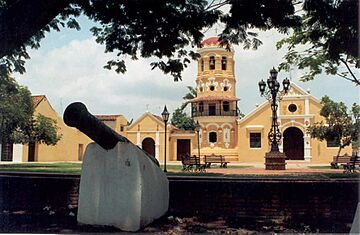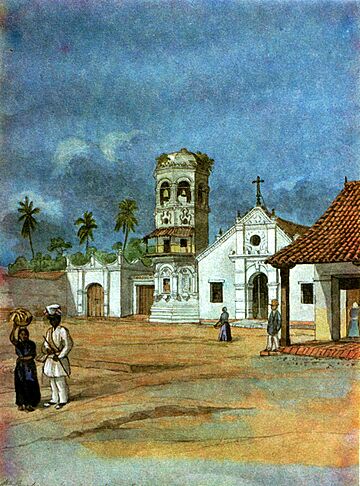History of Santa Cruz de Mompox facts for kids
| UNESCO World Heritage Site | |
|---|---|

Santa Barbara Church
|
|
| Location | Santa Cruz de Mompox, Bolívar Department, Colombia |
| Criteria | Cultural: (iv)(v) |
| Inscription | 1995 (19th Session) |
Mompox is a historic town in Colombia. It was founded on May 3, 1537. A Spanish leader named Don Juan Quintero de Heredia started the town. He did this after battles with local tribes, defeating their leader, Chief Mompoj.
The town's name, Mompox, comes from this powerful Chief Mompoj. His tribe, the Malibu Indians, lived in the area. Chief Mompoj led about fifty smaller tribes. These tribes worked together through alliances. They respected Chief Mompoj's authority. His main helpers were chiefs Zuzua and Mahamon.
Over time, the name changed from "Santa Cruz de Mompox" to simply "Mompox." This change happened around 1812. Both "Mompox" and "Mompos" are still used today.
Life in Colonial Mompox
During the 1600s, Mompox grew a lot. A new church and school were built. The school, called San Carlos, taught young people important subjects. These included Latin, philosophy, and theology.
Mompox became famous for its gold work. Local workshops created beautiful jewelry. This brought many visitors to the town. People also made clay pots and glazed decorations. Mompox was also known for its delicious sweets and jellies.
The town had six churches. One church had a stunning Baroque bell tower. Mompox was a busy trading center. Its location on the Magdalena River was very important. This made Mompox one of the richest cities in the New Kingdom of Granada. Important people, including nobles, visited Mompox. Even pirates like John Hawkins were said to be attracted to its wealth.
Many important families lived in Mompox. They managed large farms and gold mines from here. For example, José Fernando de Mier y Guerra helped settle new towns. He also controlled many properties. These families played a big role in the region's history.
The famous explorer Alexander von Humboldt also stayed in Mompox. He lived in a house by the Magdalena River.
Mompox and Independence
Mompox played a key role in Colombia's fight for freedom. It was the first town in the New Kingdom of Granada to declare complete independence from Spain. This happened on August 6, 1810. Their motto was "to be free or to die."
At this time, the Spanish leader was Vicente Talledo. But local leaders, like Pantaleón Germán de Ribón, wanted independence. Tensions grew between them. Talledo tried to stop the rebels. However, a local priest burned evidence against them.
On April 24, 1810, local militias marched in a Holy Week parade. They were led by Pantaleón Germán del Ribón. The Spanish troops were outnumbered and stepped back. This showed the growing power of the independence supporters.
Commander Talledo became more strict. He even accused a rich merchant of spying for Napoleon. This made the townspeople very angry. The merchant's family and people from nearby towns protested. Talledo had to flee Mompox on July 2. Mompox was the first town to kick out a Spanish leader.
Eighteen days later, Cartagena also declared its independence. A witness described the celebration in Mompox:
"Some of them jumped, some shouted, and all looked anxiously among the crowd, to their tenderest friends, to salute them with the ardor of liberty. The noise of the bells, the gunpowder, the music, and a thousand cheers and enthusiastic cheers raised the spirit and caused a kind of singular alienation."
On August 6, 1810, Mompox held its first open town meeting. Leaders declared absolute independence from Spain. They sent a copy of their declaration to Cartagena. They also ordered freedom for enslaved people. They wanted to destroy tools used by the Inquisition.
However, Cartagena feared this bold move. It declared war on Mompox. This caused the first civil conflict in the region.
Mompox's Role in the Second War
Mompox again declared full independence from Spain on August 6, 1811. The motto was still "to be free or to die."
After a difficult battle, Simón Bolívar, a great leader, came to Mompox. He gathered 400 soldiers from Mompox. With these troops and others, he began a famous military campaign. This campaign ended in Caracas, Venezuela, on August 6, 1813. Bolívar said, "If Caracas I owe the life to Mompox I owe the glory." This shows how important Mompox's support was to him.
Mompox was a very rich city. It was a vital port on the Magdalena River. Goods and travelers passed through Mompox to reach the rest of the country. This prosperity lasted until the early 1900s. Then, the river's path changed. This caused less traffic to come through Mompox.
Mompox is still called the "Valerous City" and "Cultured City." This is because of its brave people and important history.


